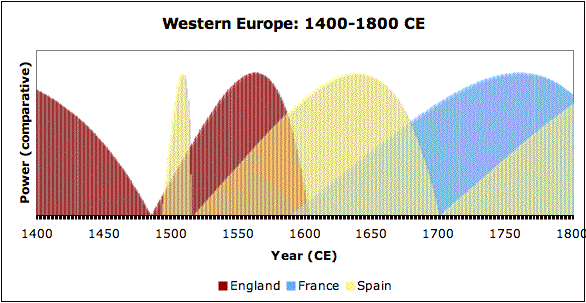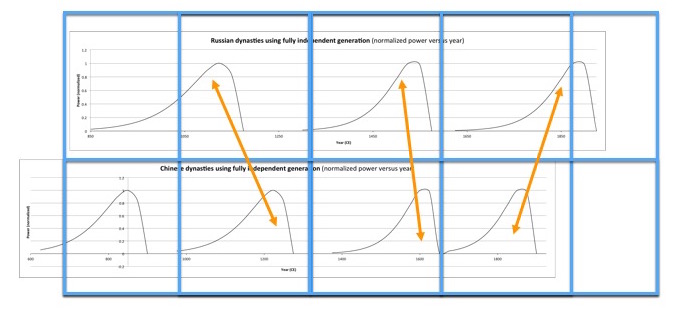Physical History
Interrelations Between Concurrent Dynasties
By Mark Ciotola
First published on May 17, 2019. Last updated on January 19, 2021.
Simultaneously Existing Regimes
A Hewett-Hubbert Curve is a fairly robust creature, but it can still be affected by simultaneous or co-existing regimes or even overwhelmed. Potentials can exist between regimes, such as in the case where one regime has a persistent trade deficit with a co-existing regime.
Only something out of a science fiction movie could have eliminated either the Roman Empire or the Chinese Tang dynasty at their heights, for example. The Hewett-Hubbert curves for the very largest human regimes in history will be largely independent of each other. Many smaller regimes are still powerful enough to be fairly robust. However, regimes of small states that are highly affected by their neighbors. Likewise, new or dying regimes of larger states lie along portions of their Hubbert curves that are not as robust as middle portions.
Such vulnerable regimes may have Hubbert Curves that are abruptly terminated rather than gradually terminated. The remaining critical resource of the regime must either be considered to have been discarded, or must be consolidated into the Hubbert Curve of a conquering regime. Such consolidation can be handled by superposition.
Dynasties as a Set of Co-Existing Regimes
Series of dynasties can be modeled, considered and plotted as a set of co-existing regimes without regard to interactions between them (see below figure).

Dynasties, England, France and Spain, 1400-1800 CE
Modeling History As A Set of Interacting Regimes
Regimes often interact with each other. Therefore, one regime can impact another. This interaction can become quite complicated, especially for smaller regimes. However, the largest, most durable regimes can be studied, for there is often more data for them and they tend to be somewhat less affected by other regimes, so that the effects are more discernable.

Possible interdependence between Chinese and Russian dynasties
The China Clock
Disclaimer: this example only applies to history preceding 1911. Since that time, China has had new forms of government and has also embraced fossil fuels. So regimes since 1911 will have fundamental characteristics that are different from those of traditional regimes. This same disclaimer could apply to most other contemporary societies as well.
To study a system of interacting regimes, it is best to study the greatest series of regimes. China has historically described itself as the central kingdom. Then have other historic regimes circles about china as do the planets circle around the Sun in a heliocentric system of astronomy? Does PHE propose a Sinocentric sociology? Yes, but to a limited degree. The mass of the sun is about thousand times greater than that of even the largest planet Jupiter. The social “mass” of China is generally historically larger than that of other societies, but not by far of such a high proportion, and at times other empires have eclipsed or absorbed China’s social “mass.” Yet to the extent that there has been anysolar equivalent in history, it would be China. Further, the Han people of China has exhibited a series of traditional regimes for a much longer period than any other single society, so it could be argued that it is the closest thing that exists to a historical “clock.” Yet perhaps and argument could be made for central Asia being such a clock, since its invasions have frequently affected societies in the continents of Asia, Europe and Africa. What drives the waves of invasions in history of central Asia? Is it a social cause or the build-up of a resource-driven potential? The answer to this question is not well known.
TABLE: Major Traditional Regime Series for China
| Dates (CE) | Regime | Duration |
|---|---|---|
| -2000–1500 BCE | Hsia | 500 years |
| -1500–1028 BCE | Shang | 472 years |
| -1028–642* BCE | Chou 1 | 386 years |
| -642*–256 BCE | Chou 2 | 386 years |
| -202–220 CE | Han | 422 years |
| 618–906 CE | Tang | 288 years |
| 960–1279 CE | Sung | 319 years |
| 1368–1644 CE | Ming | 276 years |
| 1644–1912 CE | Manchu | 268 years |
* Chou dynasty became essentially symbolic by about 700 BC, and China was chiefly ruled by small states during this symbolic “second” Chou dynasty.
So at times that China is ruled by a regime during the strong part of its lifecycle, does this block the Central Asiatic invaders so that their only outset is India, the Middle-East or Europe? The answer to this question depends upon several factors and changes depending on the state of those factors at a given time.
The following table shows several strong traditional regimes in China and corresponding waves of invasions in Europe. This list is not complete, but is suggestive for several regimes.
TABLE: Major Traditional Regime Series for China and Asiatic Invasions in European (CE)
| Dates | Regime | Duration | Invasion | |
|---|---|---|---|---|
| 618–906 | Tang | 288 years | Lombards & Avars | |
| 960–1279 | Sung | 319 years | Slavs & Magyars | |
| 1368–1644 | Ming | 276 years | Ottoman Turks |
Yet there are exceptions. The Huns, and later the Mongols, overwhelmed both China and much of the West. Conversely, a strong Roman empire might have pushed the Huns eastward before they went Westward, for the Huns attacked China in 317, while they did not invade western Europe until the mid 400s.It could be the coincidence of strong empires in both the East and the West built up potential in central Asia up to the point that the Huns became extremely potent. That both Russia and China were both relatively strong during the time of the Sung dynasty may have contributed to a build-up of potential in central Asia that helped the Mongols become so powerful. Such speculation should not detract from the achievements Mongols such as their innovative battle tactics. (The author is not as familiar with the history the Huns, so cannot comment further upon them).
« Modeling History as A Series of Dynasties | COURSE | The Colossus Model of World History »